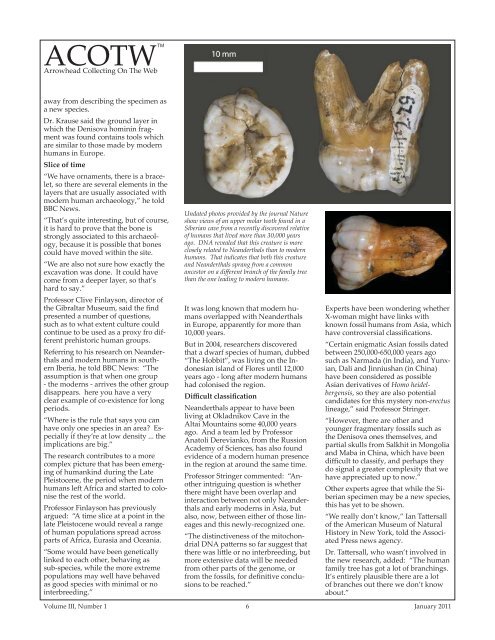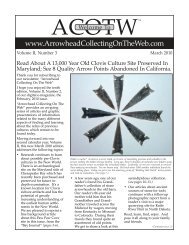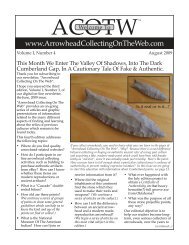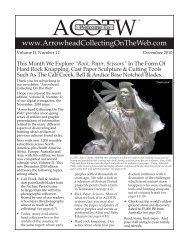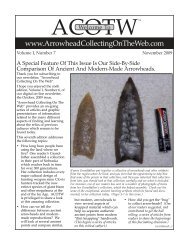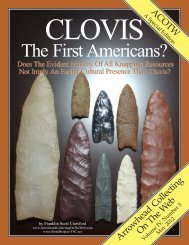Acotw - Arrowhead Collecting On The Web
Acotw - Arrowhead Collecting On The Web
Acotw - Arrowhead Collecting On The Web
Create successful ePaper yourself
Turn your PDF publications into a flip-book with our unique Google optimized e-Paper software.
ACOTW<br />
TM<br />
<strong>Arrowhead</strong> <strong>Collecting</strong> <strong>On</strong> <strong>The</strong> <strong>Web</strong><br />
away from describing the specimen as<br />
a new species.<br />
Dr. Krause said the ground layer in<br />
which the Denisova hominin fragment<br />
was found contains tools which<br />
are similar to those made by modern<br />
humans in Europe.<br />
Slice of time<br />
“We have ornaments, there is a bracelet,<br />
so there are several elements in the<br />
layers that are usually associated with<br />
modern human archaeology,” he told<br />
BBC News.<br />
“That’s quite interesting, but of course,<br />
it is hard to prove that the bone is<br />
strongly associated to this archaeology,<br />
because it is possible that bones<br />
could have moved within the site.<br />
“We are also not sure how exactly the<br />
excavation was done. It could have<br />
come from a deeper layer, so that’s<br />
hard to say.”<br />
Professor Clive Finlayson, director of<br />
the Gibraltar Museum, said the fi nd<br />
presented a number of questions,<br />
such as to what extent culture could<br />
continue to be used as a proxy fro different<br />
prehistoric human groups.<br />
Referring to his research on Neanderthals<br />
and modern humans in southern<br />
Iberia, he told BBC News: “<strong>The</strong><br />
assumption is that when one group<br />
- the moderns - arrives the other group<br />
disappears. here you have a very<br />
clear example of co-existence for long<br />
periods.<br />
“Where is the rule that says you can<br />
have only one species in an area? Especially<br />
if they’re at low density ... the<br />
implications are big.”<br />
<strong>The</strong> research contributes to a more<br />
complex picture that has been emerging<br />
of humankind during the Late<br />
Pleistocene, the period when modern<br />
humans left Africa and started to colonise<br />
the rest of the world.<br />
Professor Finlayson has previously<br />
argued: “A time slice at a point in the<br />
late Pleistocene would reveal a range<br />
of human populations spread across<br />
parts of Africa, Eurasia and Oceania.<br />
“Some would have been genetically<br />
linked to each other, behaving as<br />
sub-species, while the more extreme<br />
populations may well have behaved<br />
as good species with minimal or no<br />
interbreeding.”<br />
Undated photos provided by the journal Nature<br />
show views of an upper molar tooth found in a<br />
Siberian cave from a recently discovered relative<br />
of humans that lived more than 30,000 years<br />
ago. DNA revealed that this creature is more<br />
closely related to Neanderthals than to modern<br />
humans. That indicates that both this creature<br />
and Neanderthals sprang from a common<br />
ancestor on a diff erent branch of the family tree<br />
than the one leading to modern humans.<br />
It was long known that modern humans<br />
overlapped with Neanderthals<br />
in Europe, apparently for more than<br />
10,000 years.<br />
But in 2004, researchers discovered<br />
that a dwarf species of human, dubbed<br />
“<strong>The</strong> Hobbit”, was living on the Indonesian<br />
island of Flores until 12,000<br />
years ago - long after modern humans<br />
had colonised the region.<br />
Diffi cult classifi cation<br />
Neanderthals appear to have been<br />
living at Okladnikov Cave in the<br />
Altai Mountains some 40,000 years<br />
ago. And a team led by Professor<br />
Anatoli Derevianko, from the Russion<br />
Academy of Sciences, has also found<br />
evidence of a modern human presence<br />
in the region at around the same time.<br />
Professor Stringer commented: “Another<br />
intriguing question is whether<br />
there might have been overlap and<br />
interaction between not only Neanderthals<br />
and early moderns in Asia, but<br />
also, now, between either of those lineages<br />
and this newly-recognized one.<br />
“<strong>The</strong> distinctiveness of the mitochondrial<br />
DNA patt erns so far suggest that<br />
there was litt le or no interbreeding, but<br />
more extensive data will be needed<br />
from other parts of the genome, or<br />
from the fossils, for defi nitive conclusions<br />
to be reached.”<br />
Experts have been wondering whether<br />
X-woman might have links with<br />
known fossil humans from Asia, which<br />
have controversial classifi cations.<br />
“Certain enigmatic Asian fossils dated<br />
between 250,000-650,000 years ago<br />
such as Narmada (in India), and Yunxian,<br />
Dali and Jinniushan (in China)<br />
have been considered as possible<br />
Asian derivatives of Homo heidelbergensis,<br />
so they are also potential<br />
candidates for this mystery non-erectus<br />
lineage,” said Professor Stringer.<br />
“However, there are other and<br />
younger fragmentary fossils such as<br />
the Denisova ones themselves, and<br />
partial skulls from Salkhit in Mongolia<br />
and Maba in China, which have been<br />
diffi cult to classify, and perhaps they<br />
do signal a greater complexity that we<br />
have appreciated up to now.”<br />
Other experts agree that while the Siberian<br />
specimen may be a new species,<br />
this has yet to be shown.<br />
“We really don’t know,” Ian Tatt ersall<br />
of the American Museum of Natural<br />
History in New York, told the Associated<br />
Press news agency.<br />
Dr. Tatt ersall, who wasn’t involved in<br />
the new research, added: “<strong>The</strong> human<br />
family tree has got a lot of branchings.<br />
It’s entirely plausible there are a lot<br />
of branches out there we don’t know<br />
about.”<br />
Volume III, Number 1 6<br />
January 2011


